Sabourin, James Noah (Corporal)
Killed in Flying Accident 1947-October-18


Birth Date: 1922-May-24
Born: Ottawa, Ontario
Son of Joseph Noah and Edith Sabourin.
Home: Ottawa, Ontario
Enlistment: Ottawa, Ontario
Enlistment Date: 1941-02-17
Service
RCAF
Unit
413 Sqn- Squadron
Ad Vigilamus Undis We watch the waves
Base
Rank
Corporal
Position
Corporal
Service Numbers
22103
Home
 Ottawa, Ontario
Ottawa, Ontario
Crew or Other Personnel
Mitchell 894
Mission
Mitchell Mk. III 894
Transport 1947-October-18 to 1947-October-18
413 (R) Photo Wing (RCAF) RCAF Rockcliffe
413 (Photographic) Squadron (Ad vigilamus undis) RCAF Rockcliffe. B-25 Mitchell aircraft 894 was missing on flight from Calgary, Alberta to Penticton, British Columbia. The aircraft encountered poor weather with icing conditions, fog and low visibility and crashed in a mountainous area near Nelson, BC with no survivors
LAC WH Molyneux (RCAF), Flight Lieutenant JL MacLeod DFC (RCAF), Flying Officer AG Robertson (RCAF), Flying Officer B Cook DFM (RCAF), Flying Officer GY Lebel DFC (RCAF), Leading Aircraftman BES Bowman (RCAF), Cpl JN Sabourin (RCAF) and two Canadian civilians, husband and wife Fred and Beulah Knight were all missing, presumed killed in this flying accident
A massive search was undertaken, covering 30,000 square miles, which failed to find the aircraft or survivors after a search lasting four weeks
On October 7, 1952, Mr Wilf Gibbard caught sunlight glinting off a piece of aluminum high on Record Mountain, near Rossland, BC while out hunting and Mitchell 894 was finally found
No human remains were found at the crash site and the missing have no known grave. They are commemorated on the Ottawa Memorial. A cairn was also erected at the crash site, October 14, 1952 to commemorate all lost in the crash
RCAF 894 was built for the USAAF as B25D-1 serial 41-29877 and converted to F-10 photo configuration before delivery to RCAF on 23 April 44. She was part of the "˜Photographic Flight,' later known as No. 413 (P) Squadron, from RCAF Rockcliffe, Ontario with tri-camera survey installation. She operated in British Columbia in late 1947 until lost
 The last flight of Penticton-bound RCAF Mitchell 894 I iNFOnews I ...
The last flight of Penticton-bound RCAF Mitchell 894 I iNFOnews I ...
Mitchell serial: 894
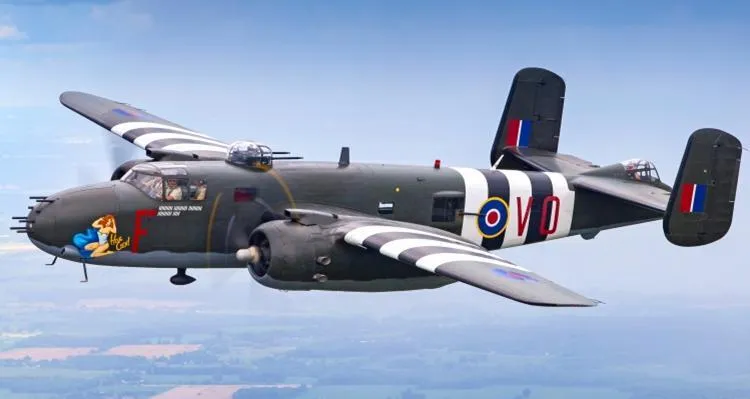
Canadian Warplane Heritage Museum
The North American B-25 Mitchell is an American medium bomber that was introduced in 1941 and named in honor of Major General William "Billy" Mitchell, a pioneer of U.S. military aviation. Used by many Allied air forces, the B-25 served in every theater of World War II, and after the war ended, many remained in service, operating across four decades. Produced in numerous variants, nearly 10,000 B-25s were built.
The North American B-25 Mitchell was flown by the RCAF during and after the Second World War. The RCAF flew the B-25 Mitchell for training during the war and continued flying operations after the war, in Canada with most of 162 Mitchells received. The first B-25s had originally been diverted to Canada from RAF orders. These included one Mitchell Mk. I, 42 Mitchell Mk. IIs, and 19 Mitchell Mk. IIIs. No 13 (P) Squadron was formed unofficially at RCAF Station Rockcliffe in May 1944 and flew Mitchell Mk. IIs on high-altitude aerial photography sorties. No. 5 OTU (Operational Training Unit) at Boundary Bay, British Columbia and Abbotsford, British Columbia, operated the B-25D Mitchell in a training role together with B-24 Liberators for Heavy Conversion as part of the BCATP. The RCAF retained the Mitchell until October 1963.
No. 418 (Auxiliary) Squadron received its first Mitchell Mk. IIs in January 1947. It was followed by No. 406 (Auxiliary), which flew Mitchell Mk. IIs and Mk. IIIs from April 1947 to June 1958. No. 418 Operated a mix of Mk. IIs and Mk. IIIs until March 1958. No. 12 Squadron of Air Transport Command also flew Mitchell Mk. IIIs along with other types from September 1956 to November 1960. In 1951, the RCAF received an additional 75 B-25Js from USAF stocks to make up for attrition and to equip various second-line units.. Wikipedia and Harold Skaarup web page
Unit Desciption
413 Sqn Ad Vigilamus Undis ("Tusker")
History of the Squadron during World War II (Aircraft: Catalina I, IB, IV)

The squadron was formed as the eleventh RCAF squadron created overseas in WWII. It was formed in Stranraer, Scotland on July 1, 1941 as a flying boat General Reconnaissance unit, flying Catalina aircraft on reconnaissance and anti-submarine patrols. It flew from Stranraer and from Sullom Voe in the Shetland Islands. In March 1942 it was hurriedly sent to the Far East, to Koggala in Ceylon (Sri Lanka) , and was pressed into service to maintain reconnaissance to watch for the Japanese fleet that was thought to be on the way to attack Ceylon. Indeed, the fleet was detected by Squadron Leader L.J. Birchall on April 4, 1942 and the defenders in Ceylon were alerted so that the invasion did not take place. S/L Birchall was awarded the DFC for his operation, on which he was shot down and taken as a POW. The squadron remained in Ceylon, with outposts at different locations in the Indian Ocean until January 1945. The squadron personnel were returned to England by sea, and the squadron was disbanded at Bournemouth, England on February 23, 1945.
In the course of operations the squadron logged over 11,500 operational hours for the loss of 3 aircraft, with 27 aircrew being killed, missing or POW. Squadron members were awarded 1 DSO, 4 DFCs, 2 AFCs and 1 MiD. Battle Honours were: Atlantic 1941-43, Ceylon 1942, Eastern Waters 1942-44.Wikipedia, Kostenuk and Griffin
Maps for Movements of 413 Squadron 1941-45
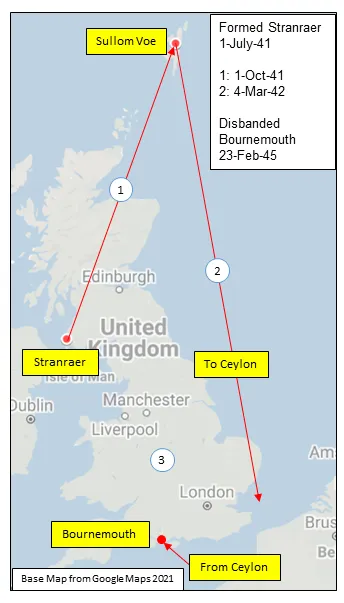
MAP 1: 413 Squadron Movements 1941-45(right-click on image to display enlarged in new tab)
|
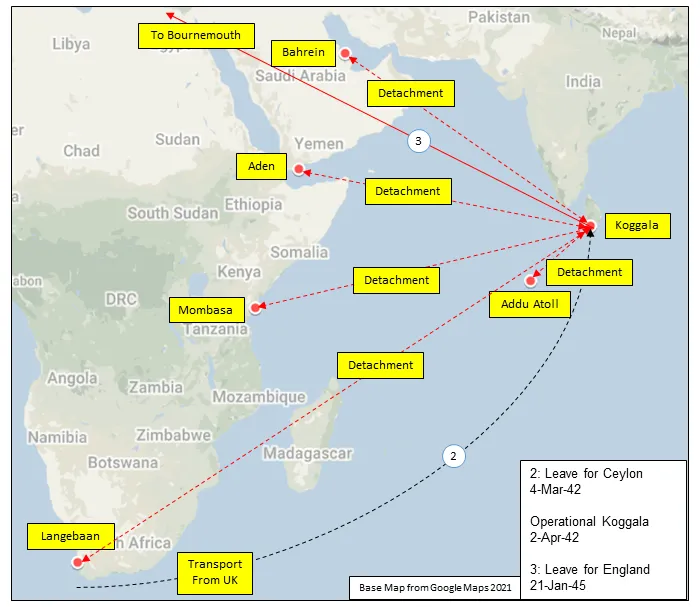
MAP 2: 413 Squadron Bases in the Indian Ocean 1942-45
|
413 Squadron History Summary 1941-45
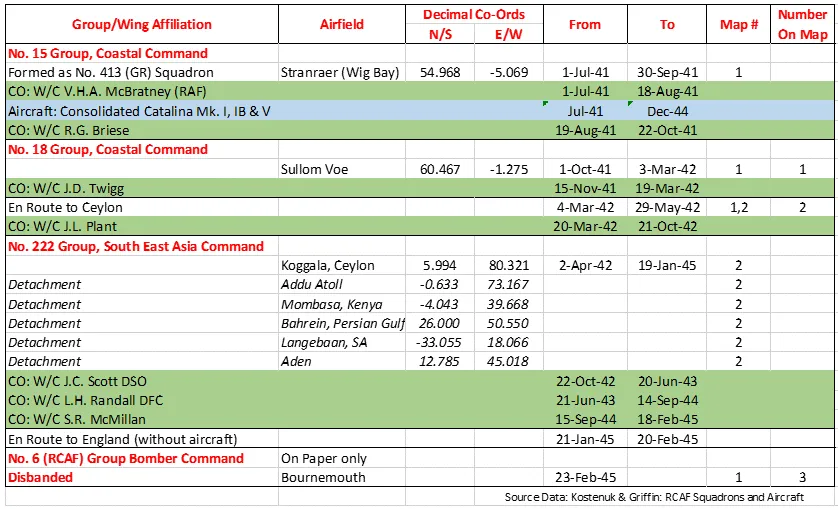
History of the Squadron Post-WWII (Aircraft: Lancaster X, Mitchell II, Canso A, Norseman, Sabre II & V, Canuck, Labrador, Hercules, Cormorant)
Re-created at RCAF Rockcliffe, Ontario on April 1, 1947, it took over the duties of No. 13 (Photographic) Squadron, flying Avro Lancaster X, North American Mitchell II, Consolidated Canso A and Noorduyn Norseman aircraft. It operated in this photographic role until November 1, 1950, when it was disbanded.
The squadron re-formed again on August 1, 1951, as a fighter squadron at CFB Bagotville, Quebec . Equipped with the F-86 Sabre II and V they deployed to Zweibrücken, Germany in April 1953. In 1956, it was decided to replace one Sabre squadron in each of the Air Division Europe with an all-weather fighter unit. The squadron accordingly was stood down on April 7, 1957, returned to Canada and was then reactivated on May 1 as an all-weather fighter squadron, operating the Avro CF-100 Canuck out of Bagotville. The squadron again disbanded on December 30, 1961.
The squadron was reactivated at CFB Summerside, Prince Edward Island on July 8, 1968, in its current role of a Transportation and Rescue Squadron. With the closure of Summerside, the squadron relocated to CFB Greenwood, Nova Scotia on June 10, 1991. The CH-113 Labrador helicopter was used during this time. The present duties of the squadron are to conduct search and rescue and airlift throughout an 1,800,000 square mile area in eastern Canada. As the primary air search and rescue unit on Canada's East Coast, 413 Squadron crews cover an area extending from the south of Nova Scotia, north to Iqaluit on Baffin Island as far west as Quebec City and east out to the middle of the Atlantic. The Joint Rescue Coordination Centre, Halifax (JRCC) operationally controls one Hercules and four Cormorant Aircraft for primary Search and Rescue response. 413 Squadron has crews on standby 24-hours a day to respond to marine vessels or aircraft in distress, to carry out medical evacuations, or search for missing persons year round. 413 Squadron has an intimate working relationship with the non-profit Civil Air Search and Rescue Association (CASARA) in the Maritimes and Newfoundland/Labrador. Both the Hercules and the Cormorant carry out annual visits to each of the zones in the Halifax Search and Rescue Region to assist in the training of CASARA member as spotters. 413 Squadron also provides one Hercules aircraft for global strategic transport. Missions include humanitarian airlift and support of other units of the Canadian Forces. Generally the destinations are in North America, the Caribbean, or Western Europe, but could be anywhere in the world.
 Canadian Virtual War Memorial
Canadian Virtual War Memorial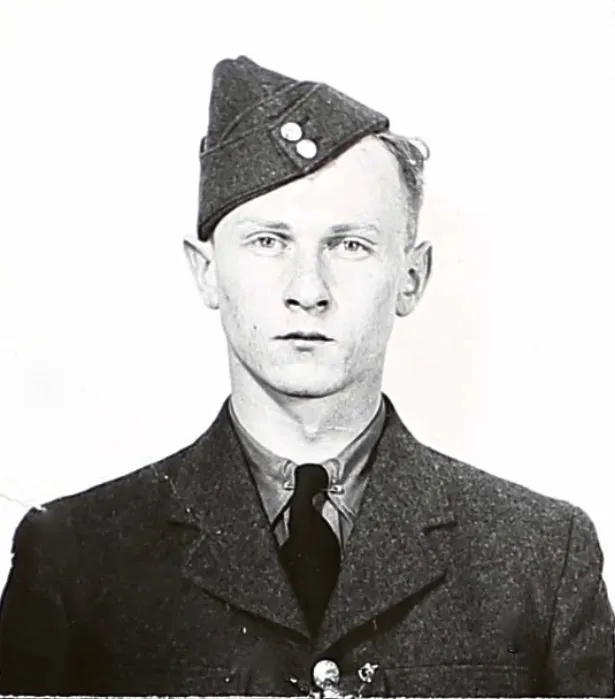



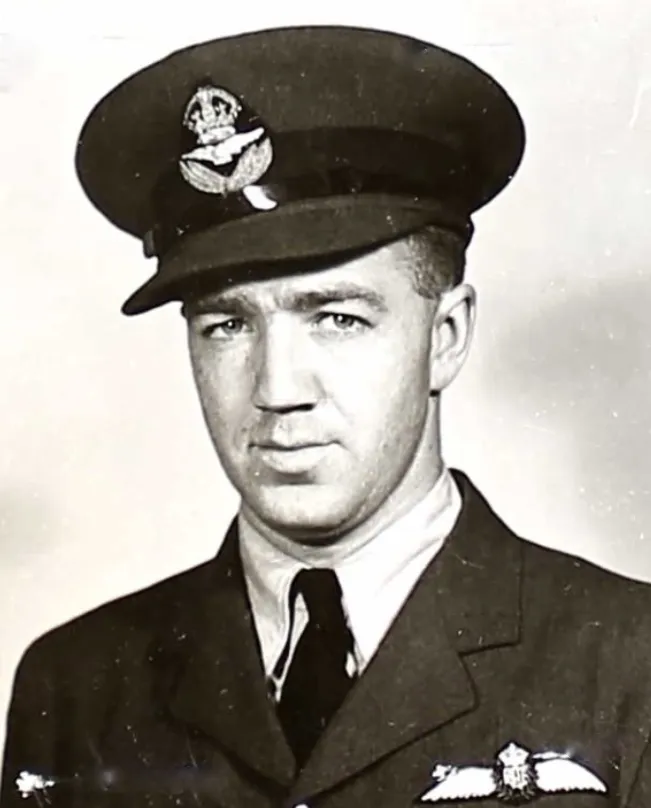
 Mitchell Bomber
Mitchell Bomber Wikipedia Mitchell Bomber
Wikipedia Mitchell Bomber